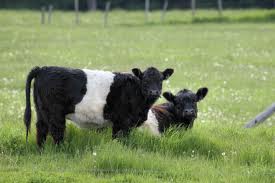How can six cows become such an attraction? There was much talk of it last year, but finally, with little warning, six Aberdeen Angus cows arrived in Sunbury Park. They are there as a trial for 8 weeks in a bid to improve biodiversity and control invasive grassland species. They are now famous! The Daily Telegraph wrote that Sunbury had been “over run by cows”. Even the ITV news ran with the story of our new addition.
As a park user and dog owner myself I was curious, enchanted…and finally not so happy when one of my dogs rolled in a cow pat. However, after a few weeks, if I walk the dogs and we don’t meet the cows (they sometimes hide in the bushes) I somehow feel disappointed. There is no doubt that there is a lot of interest and curiosity about them.
I have never seen so many families in the park at weekends. The ‘pesky kids’ who initially enjoyed chasing the cows seem to have found better things to do. Some of the more nervous dog walkers seem to be venturing back and things have calmed down.
So we got talking to some of the older residents of Sunbury and got to know the park better, or rather had a look back in time. What we found out was fascinating.
The park was of course not always a park
In 1851 the Arden family acquired the site and built a large double winged house with 40 bedrooms and a ballroom. During the Great War, it was used as an officer’s mess. After that, the family didn’t actually live in it again. Sunbury resident Dennis Brock (who was born in 1918) remembers playing in the dilapidated house as a child, having climbed over the wall on Thames Street with friends.
He remembers flaking plaster coving, rotting floor boards and a large spiral staircase. It must have been very grand at one point but during WW2 its only use was by the fire brigade for practice.
Many of you older residents will recall that cows were grazed in Sunbury Park until the 1950’s. Dairyman Charlie Davies who had his farm on Manor Lane (the entrance was at Griffin Way), had a herd of 50 cows and his own bull. He used to drive the cows morning and evening up and down Green Street (which at the time was lined with elm trees) to put them out to graze.
At the back of the Walled Garden on the park side you may have noticed a wall with markings, looking like dividers. These were from the pig pens as the land was used for farming. Imagine that – pigs in Sunbury Park!
In the late 1930’s the park was also the site of the annual Sunbury Fair, where local teams from the Gas Works and the Fire Brigade played ‘push ball’. This is game using a ball 6 feet (1.83 m) in diameter and 50 lb (22.7 kg) in weight. Two teams push it towards a goal. The Fire Brigade also put on demonstrations of their hose skills.
If you walk through the park and lose your footing, it may be in one of the bomb craters, as bombs fell from The Avenue all the way to the river in WW2.
In the late 1950’s local Stan Hicks lived in a caravan beside the old coach house which was on the site of the Walled Garden car park. He showed me his driving licence from that time which states his address as Sunbury Park, Sunbury on Thames. He remembers both cows and pigs. He also showed me where there was a stair case at the back of the Walled Garden, leading to a boiler room to heat the greenhouses. There is no trace of it now.
The ‘Arden’ House was finally pulled down in 1946. In 1975, Sunbury Park was bought from private ownership by Surrey County Council and was subsequently leased to Spelthorne Council.
Should the current trial grazing be deemed a success we are likely to see cows in the park for 3-4 months of the year, hopefully amongst wild flowers and bees. There is no doubt that this is a change to our everyday life, but is it so bad? Seeing dads with kids standing amongst these big docile beasts is really quite special. It is the closest many of our kids will get to farm animals.
Fears about plots to reclassify this land as agricultural and sell it on for housing are unfounded, according to the council. Steve Price, countryside and commons officer at Spelthorne Council says “I can rebuff any proposal of land designation or development and actually state that if anything what we are trying to achieve would combat such claims.”

